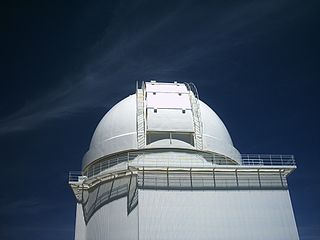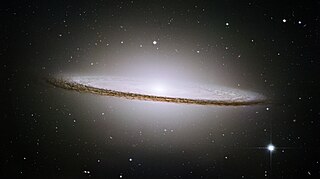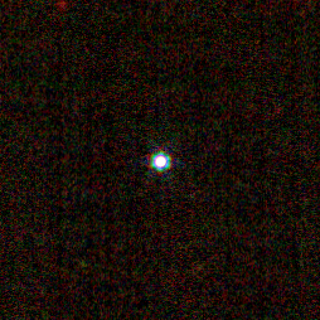Related Research Articles

An optical spectrometer is an instrument used to measure properties of light over a specific portion of the electromagnetic spectrum, typically used in spectroscopic analysis to identify materials. The variable measured is most often the irradiance of the light but could also, for instance, be the polarization state. The independent variable is usually the wavelength of the light or a closely derived physical quantity, such as the corresponding wavenumber or the photon energy, in units of measurement such as centimeters, reciprocal centimeters, or electron volts, respectively.

The Very Large Telescope (VLT) is an astronomical facility operated since 1998 by the European Southern Observatory, located on Cerro Paranal in the Atacama Desert of northern Chile. It consists of four individual telescopes, each equipped with a primary mirror that measures 8.2 meters in diameter. These optical telescopes, named Antu, Kueyen, Melipal, and Yepun, are generally used separately but can be combined to achieve a very high angular resolution. The VLT array is also complemented by four movable Auxiliary Telescopes (ATs) with 1.8-meter apertures.

Subaru Telescope is the 8.2-metre (320 in) telescope of the National Astronomical Observatory of Japan, located at the Mauna Kea Observatory on Hawaii. It is named after the open star cluster known in English as the Pleiades. It had the largest monolithic primary mirror in the world from its commissioning until the Large Binocular Telescope opened in 2005.

The Large Binocular Telescope (LBT) is an optical telescope for astronomy located on 10,700-foot (3,300 m) Mount Graham, in the Pinaleno Mountains of southeastern Arizona, United States. It is a part of the Mount Graham International Observatory.

The W. M. Keck Observatory is an astronomical observatory with two telescopes at an elevation of 4,145 meters (13,600 ft) near the summit of Mauna Kea in the U.S. state of Hawaii. Both telescopes have 10 m (33 ft) aperture primary mirrors, and, when completed in 1993 and 1996, they were the largest optical reflecting telescopes in the world. They have been the third and fourth largest since 2006.

A grism is a combination of a prism and grating arranged so that light at a chosen central wavelength passes straight through. The advantage of this arrangement is that one and the same camera can be used both for imaging and spectroscopy without having to be moved. Grisms are inserted into a camera beam that is already collimated. They then create a dispersed spectrum centered on the object's location in the camera's field of view.

The Calar Alto Observatory is an astronomical observatory located in Almería province in Spain on Calar Alto, a 2,168-meter-high (7,113 ft) mountain in the Sierra de Los Filabres subrange of the Sierra Nevada.

Donald F. Figer is an American astronomer and a professor in the College of Science of the Rochester Institute of Technology. He is also the director of RIT's Future Photon Initiative, Center for Detectors, and Rochester Imaging Detector Laboratory. His research interests include massive stars, massive star clusters, red supergiants, the Galactic Center, and the development of advanced technologies for astrophysics and a broad range of applications.

The Cosmic Origins Spectrograph (COS) is a science instrument that was installed on the Hubble Space Telescope during Servicing Mission 4 (STS-125) in May 2009. It is designed for ultraviolet (90–320 nm) spectroscopy of faint point sources with a resolving power of ≈1,550–24,000. Science goals include the study of the origins of large scale structure in the universe, the formation and evolution of galaxies, and the origin of stellar and planetary systems and the cold interstellar medium. COS was developed and built by the Center for Astrophysics and Space Astronomy (CASA-ARL) at the University of Colorado at Boulder and the Ball Aerospace and Technologies Corporation in Boulder, Colorado.

A low-ionization nuclear emission-line region (LINER) is a type of galactic nucleus that is defined by its spectral line emission. The spectra typically include line emission from weakly ionized or neutral atoms, such as O, O+, N+, and S+. Conversely, the spectral line emission from strongly ionized atoms, such as O++, Ne++, and He+, is relatively weak. The class of galactic nuclei was first identified by Timothy Heckman in the third of a series of papers on the spectra of galactic nuclei that were published in 1980.
The SOPHIEéchelle spectrograph is a high-resolution echelle spectrograph installed on the 1.93m reflector telescope at the Haute-Provence Observatory located in south-eastern France. The purpose of this instrument is asteroseismology and extrasolar planet detection by the radial velocity method. It builds upon and replaces the older ELODIE spectrograph. This instrument was made available for use by the general astronomical community October 2006.

Integral field spectrographs (IFS) combine spectrographic and imaging capabilities in the optical or infrared wavelength domains (0.32 μm – 24 μm) to get from a single exposure spatially resolved spectra in a bi-dimensional region. The name originates from the fact that the measurements result from integrating the light on multiple sub-regions of the field. Developed at first for the study of astronomical objects, this technique is now also used in many other fields, such as bio-medical science and Earth remote sensing. Integral field spectrography is part of the broader category of snapshot hyperspectral imaging techniques, itself a part of hyperspectral imaging.

The Gemini Planet Imager (GPI) is a high contrast imaging instrument that was built for the Gemini South Telescope in Chile. The instrument achieves high contrast at small angular separations, allowing for the direct imaging and integral field spectroscopy of extrasolar planets around nearby stars. The collaboration involved in planning and building the Gemini Planet imager includes the American Museum of Natural History (AMNH), Dunlap Institute, Gemini Observatory, Herzberg Institute of Astrophysics (HIA), Jet Propulsion Laboratory, Lawrence Livermore National Lab (LLNL), Lowell Observatory, SETI Institute, The Space Telescope Science Institute (STSCI), the University of Montreal, University of California, Berkeley, University of California, Los Angeles (UCLA), University of California, Santa Cruz (UCSC), University of Georgia.

2MASS J04151954−0935066 is a brown dwarf of spectral class T8, in the constellation Eridanus about 18.6 light-years from Earth. This is a reference (standard) object for the definition of the T8 spectral class.

2MASS J09373487+2931409, or 2MASSI J0937347+293142 is a brown dwarf of spectral class T6, located in the constellation Leo about 19.96 light-years from Earth.

Kappa Andromedae b is a directly imaged substellar object and likely superjovian-mass planet orbiting Kappa Andromedae, a young B9IV star in the Andromeda constellation, about 170 light-years away. The companion's mass is roughly 13 times the mass of Jupiter. As early history on Kappa And b is filled with debate over whether it is an exoplanet or a brown dwarf, some scientists have broadly described it as a "super-Jupiter" object.

2MASS J02431371−2453298 is a brown dwarf of spectral class T6, located in the constellation Fornax about 34.84 light-years from Earth.

The NIRSpec is one of the four scientific instruments flown on the James Webb Space Telescope (JWST). The JWST is the follow-on mission to the Hubble Space Telescope (HST) and is developed to receive more information about the origins of the universe by observing infrared light from the first stars and galaxies. In comparison to HST, its instruments will allow looking further back in time and will study the so-called Dark Ages during which the universe was opaque, about 150 to 800 million years after the Big Bang.

Spectro-Polarimetric High-contrast Exoplanet REsearch (VLT-SPHERE) is an adaptive optics system and coronagraphic facility at the Very Large Telescope (VLT). It provides direct imaging as well as spectroscopic and polarimetric characterization of exoplanet systems. The instrument operates in the visible and near infrared, achieving exquisite image quality and contrast over a small field of view around bright targets.
4C +48.48 is a radio galaxy located in the constellation Cygnus. At the redshift of 2.343, it is one of the most distant galaxies ever seen, since light has taken at least 11 billion light-years to reach Earth.
References
- ↑ Larkin, James E.; et al. (March 2003), Iye, Masanori; Moorwood, Alan F. M. (eds.), "OSIRIS: infrared integral field spectrograph for the Keck adaptive optics system", Instrument Design and Performance for Optical/Infrared Ground-based Telescopes, Proceedings of the SPIE, vol. 4841, pp. 1600–1610, Bibcode:2003SPIE.4841.1600L, doi:10.1117/12.461775.
- 1 2 Krabbe, A.; et al. (May 2006), "Diffraction-limited Imaging Spectroscopy of the Sagittarius A* Region Using OSIRIS, a New Keck Instrument", The Astrophysical Journal, 642 (2): L145–L148, arXiv: astro-ph/0605253 , Bibcode:2006ApJ...642L.145K, doi:10.1086/504587.
- ↑ Mieda, Etsuko; et al. (March 2014), "Efficiency Measurements and Installation of a New Grating for the OSIRIS Spectrograph at Keck Observatory", Publications of the Astronomical Society of the Pacific, 126 (937), arXiv: 1401.4456 , Bibcode:2014PASP..126..250M, doi:10.1086/675784.